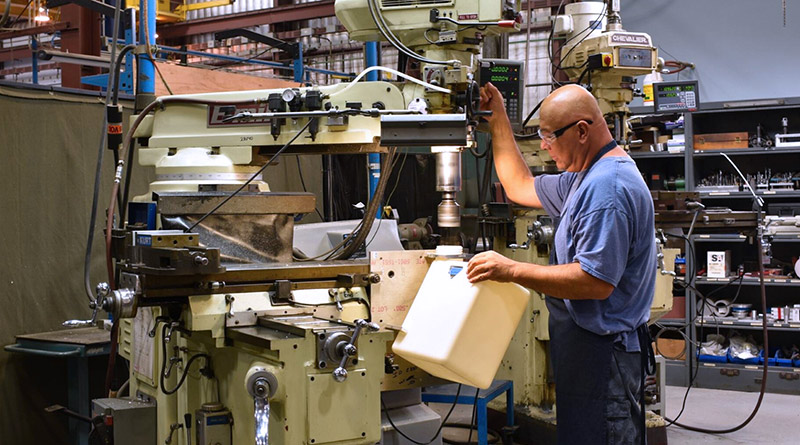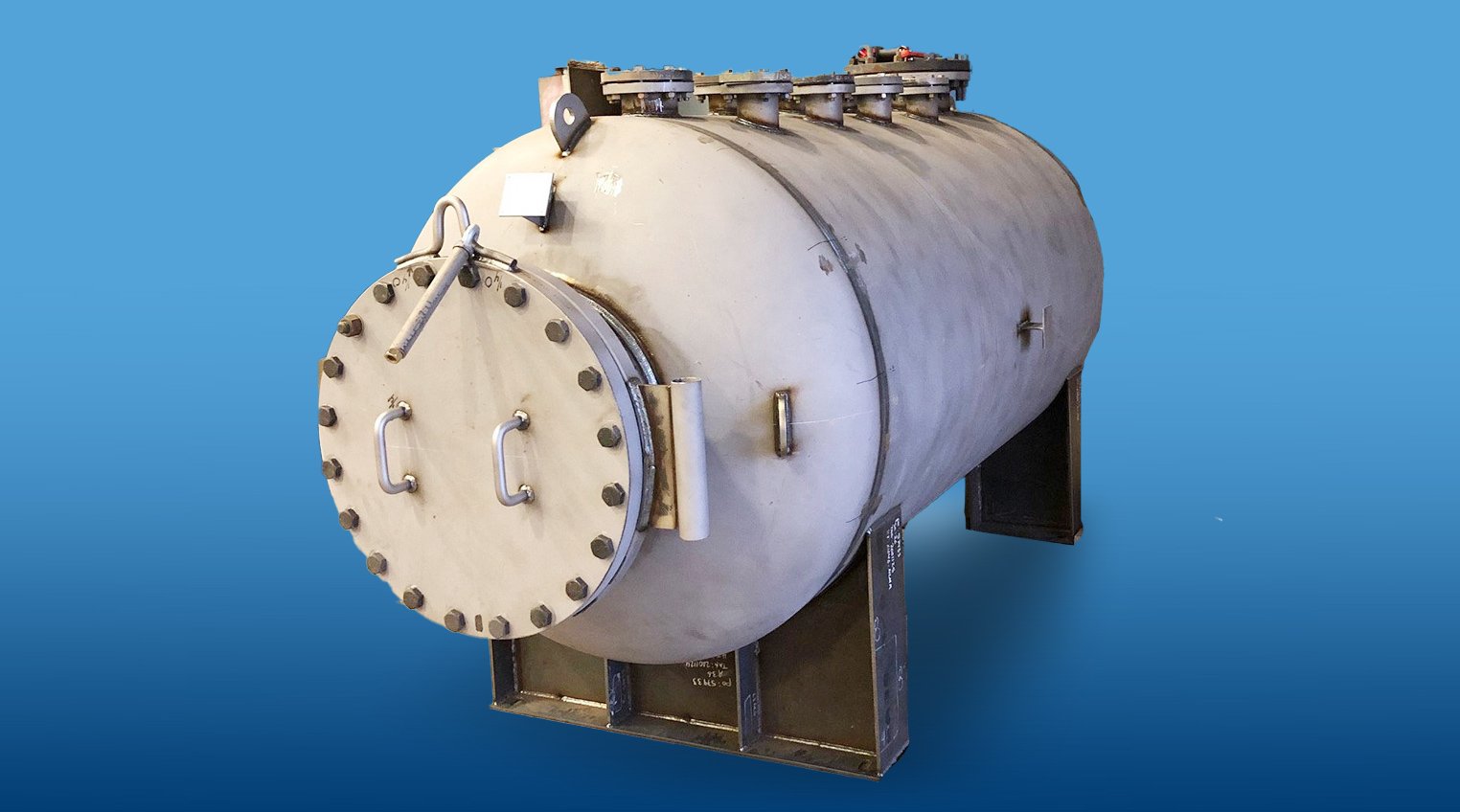Applications for High-Purity Tanks in Semiconductor Manufacturing
The many stages of semiconductor manufacturing involve a variety of liquids, from ultrapure water to harsh chemical baths. All stages require containers that will supply multiple desired characteristics. The process of rotational molding offers the opportunity to match polymer type to the application.
RMB Products’ rotomolding technology provides containers suited to the high-purity environment, with an economical choice that combines chemical compatibility with durability, The result? A product lifespan that more than satisfies the return on investment. And as fabs continue to fine-tune manufacturing processes and look for new sizes and shapes, a process as nimble as rotomolding helps serve these changing needs better than other materials or molded polymer options.
Semiconductor production stages requiring fluid containment
Various sites try to boil down semiconductor manufacturing steps into manageable bites, but it’s a daunting task. Some say six, while others say eight stages. But the truth is that within these stages, hundreds of individual steps involve liquids of some type during the months-long process of semiconductor fabrication. The rotomolding process can supply containers with superior properties compared to other technologies and materials. Areas of use include wet stations, spin processors, polymer removal stations, annealing, measurement, surface preparation, inspection and testing, and scrubbers.

The semiconductor fabrication steps that require secure, high-purity fluid containment include:
- Atomic layer deposition
- Chemical mechanical planarization
- Chemical vapor deposition
- Cleaning
- Coating/developing
- Electrochemical deposition
- Epitaxy (the process of growing a crystal)
- Etching
- Ion implantation
- Lithography
- Physical vapor deposition
- Rapid thermal processing
- Stripping
- Wafer bonding/debonding
General guidelines to follow when selecting containment materials
Each of the steps listed above will require a bottle, tank, or container for liquids, supplying secure containment while also maintaining the high-purity standards upheld in the semiconductor industry. Types of fluids and their requirements will vary.
-
Chemically inert substances. Polishing slurries normally rely on chemically inert oxides. For this and other processes that use inert liquids and/or fine grain compounds, such as a polishing compound for minimal abrasion, HDPE can provide an economical and viable material solution.
While stainless steel performs well in multiple applications, in this instance, HDPE is a superior choice, combining good impact resistance with abrasion resistance. Steel can erode rather quickly. In terms of abrasion resistance, it can be easier to sand steel than to sand HDPE, depending on the grit selected.
-
Harsh chemical bath. Wafer cleaning and etching involve a harsh chemical bath. Most etching chemicals are designed to completely eat away, at a rapid rate, specific substrate materials. Avoid any metal containers or materials that tend to oxidize quickly. RMB recommends containers rotomolded using perfluoroalkoxy (PFA) for its chemical resistance and ability to withstand elevated temperatures.
-
Sensor/fluid measurement. Semiconductor processes, such as electrochemical plating, require dosing bottles that enable fluid sensors to monitor and control fluid levels when performing chemical mixing.
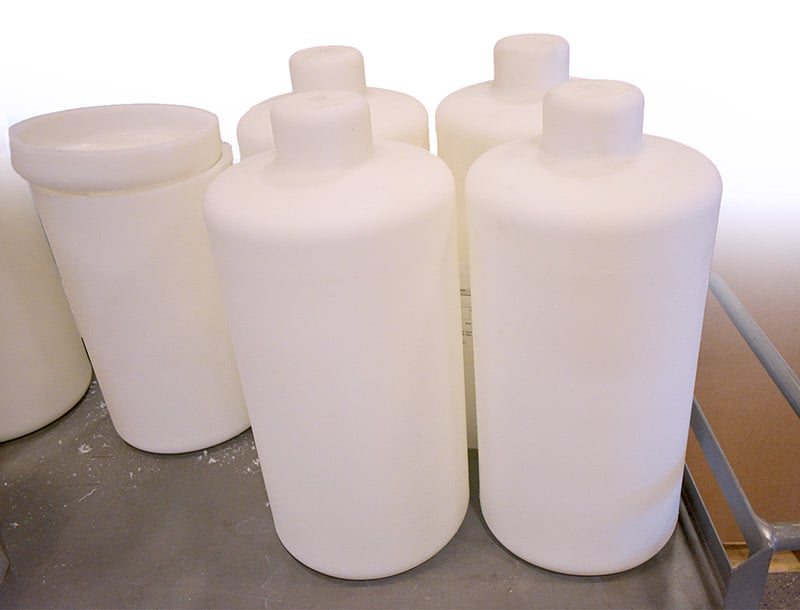
Rotomolded bottles of polypropylene supply a smooth, seamless interior, with the ability to add sensor lead lines on the sides, which follow a route around the bottle to keep the wiring clean. The rotational molding of these containers allows the ability to create snap-fit cable guides as well as a location to hardwire a sensor to its side. The weld-free interior aids with fluid recuperation and accuracy and helps avoid contamination.
The rotomolding process can add buttress threads so that bottles and containers can include caps. RMB makes different types and sizes of polypropylene bottles with buttresses and welded features on the exterior for vent ports, etc. Tracks on the side walls of molded containers such as tanks can route and cleanly organize the wiring required for sensor systems. Sensors process indirect information, reading through the tank’s wall, without requiring direct contact with the liquid.
-
Chemical mixing. Key considerations for mixing tanks include chemical compatibility, abrasion resistance, and pressure. Polypropylene tanks supply the right blend of compatibilities for mixing at atmospheric pressure. Often tanks will include a cover or lid to protect workers from splashing during the mixing process. Lids can be manufactured to allow the mixing blades to enter and exit the tank while still supplying protection.
Complete disclosure of chemical types and proportions as well as mix times/phases will guide material selection due to a couple critical factors:
-
Potential chemical reactions. These reactions are caused by mixing highly aggressive chemicals. Even a minor percentage change in the chemicals mixed within the tank can create byproducts that could react negatively with the material selected for the container. Full disclosure helps select the proper resin for the container that can resist chemical attack and optimize worker and plant safety.
-
Leftover chemicals. The failure to thoroughly clean and flush between cycles could cause an incomplete stoichiometric reaction from a leftover chemical.
In the semiconductor industry, where chemicals are mixed, an RMB PFA mixing tank can supply the chemical stability required — from chemical preparation to distribution and wash tanks.
-
Polymeric superiority compared to material alternatives
A rotationally molded tank or container from RMB provides a seamless, durable, and robust alternative to containers manufactured from stainless steel or quartz glass. Harsh chemicals can erode steel containers. Quartz glass supplies a smooth interior without weld seams; however, it is susceptible to breakage, cracks, or chips that can contaminate high-purity liquids.
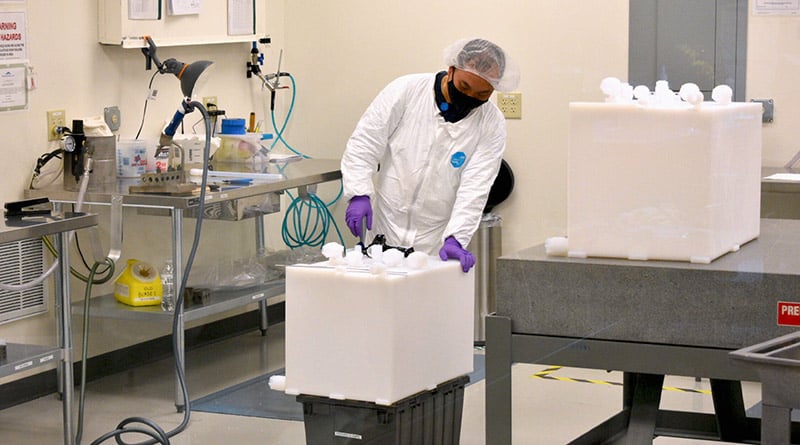
High-resistance polymers, such as HDPE, PFA, and polypropylene, are formulated to withstand the rigors of the manufacturing environment, resulting in components that will not break, shatter, or erode. Furthermore, when properly specified, these polymers help prevent the leaching of undesirable chemicals or materials in order to maintain the integrity of high-purity fluids.
Side note: Tank size correlates to the potential for contamination due to a greater surface area. The greater the surface area, the higher the potential for contamination, despite the low surface energy common to many types of high-performance polymers. Best practices in high-purity applications involve carefully considering tank size vs. desired output and staying within the size range when smaller tanks will achieve the desired objectives.
For example, if a 50-gallon tank is unavailable, don’t bump up to a 90-gallon tank, almost doubling in size based simply on availability. Contamination leads to ruined batches, which can devastate production yield.
A final consideration is aspect ratio. For example, cylindrical tanks should have an aspect ratio of 1:1 or 1:1.5 (at most).
Types of rotomolded fluid containment vessels
Here are a few examples of semiconductor fluid containment vessels:
-
Tanks. The process of planarization, or chemical polishing, uses orbital action to polish the wafer smooth and is intermediated with a chemical slurry. Rotomolded tanks can contain the chemical slurry and be fitted with or without lids.
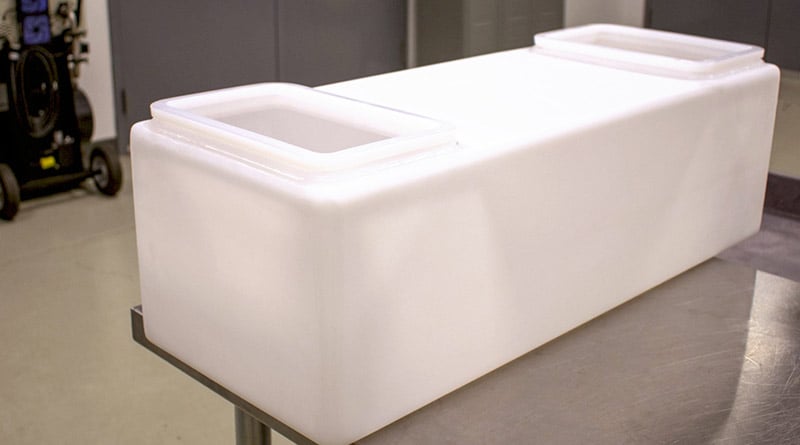
-
Rotomolded cylinders or squared-off containers. These appear on EOS platforms used to wet clean and etch wafers. Rotomolded canisters for etching and cleaning serve multiple platforms.
-
Bottles. Bottles in diverse sizes (3, 6, and 10 liters) find application in the electrochemical deposition phase for advanced wafer-level packaging and through-silicon via structure applications. At this stage, copper and other metals are deposited to create the electrical connections that power mobile electronics.
Rotomolding technology’s quick response in changing environments
As semiconductor fabs streamline manufacturing processes and redesign wet benches and other workstations, a quick turnaround can help operations continue without lost production or profitability.
Rotational molding offers a shorter timeframe from concept through production and less expensive mold requirements, which help reduce costs. The timeframe for mold development can be as little as a few weeks, compared to the time-intensive and costly mold development required for other types of molding, such as blow molding. Blow molding involves higher pressures and could require thousands of hours of machining to create the molds.
From design to shipping, RMB manages the entire rotational molding process. Its in-house capabilities are fully integrated to quickly support new mold designs and new projects. However, the best time to initiate a discussion with an RMB engineer is at the start of a project. Customers can avoid delays by quoting projects early in the process.
Contact us for more information about RMB’s experience in manufacturing high-purity containers for the semiconductor industry.

